University Assignment: Analysis of the Australian Economy 2015-2019
VerifiedAdded on 2022/10/17
|15
|2449
|406
Report
AI Summary
This report provides a comprehensive analysis of the Australian economy from 2015 to 2019, examining key macroeconomic indicators such as GDP, unemployment rate, inflation, and trade. The analysis includes a trend analysis of these indicators, including terms of trade, current account, net foreign debt, and the value of the Australian dollar. The report compares the economic performance over the specified period and highlights the current economic situation in August/September 2019. Based on the analysis, the report identifies and discusses three major issues facing the Australian economy in the next 12 months, including the potential rise in unemployment due to slowing economic growth, the impact of rising inflation on consumer purchasing power and investment, and the effects of increasing net foreign debt and a declining Australian dollar. The report concludes with a summary of the key findings and their implications for the Australian economy.
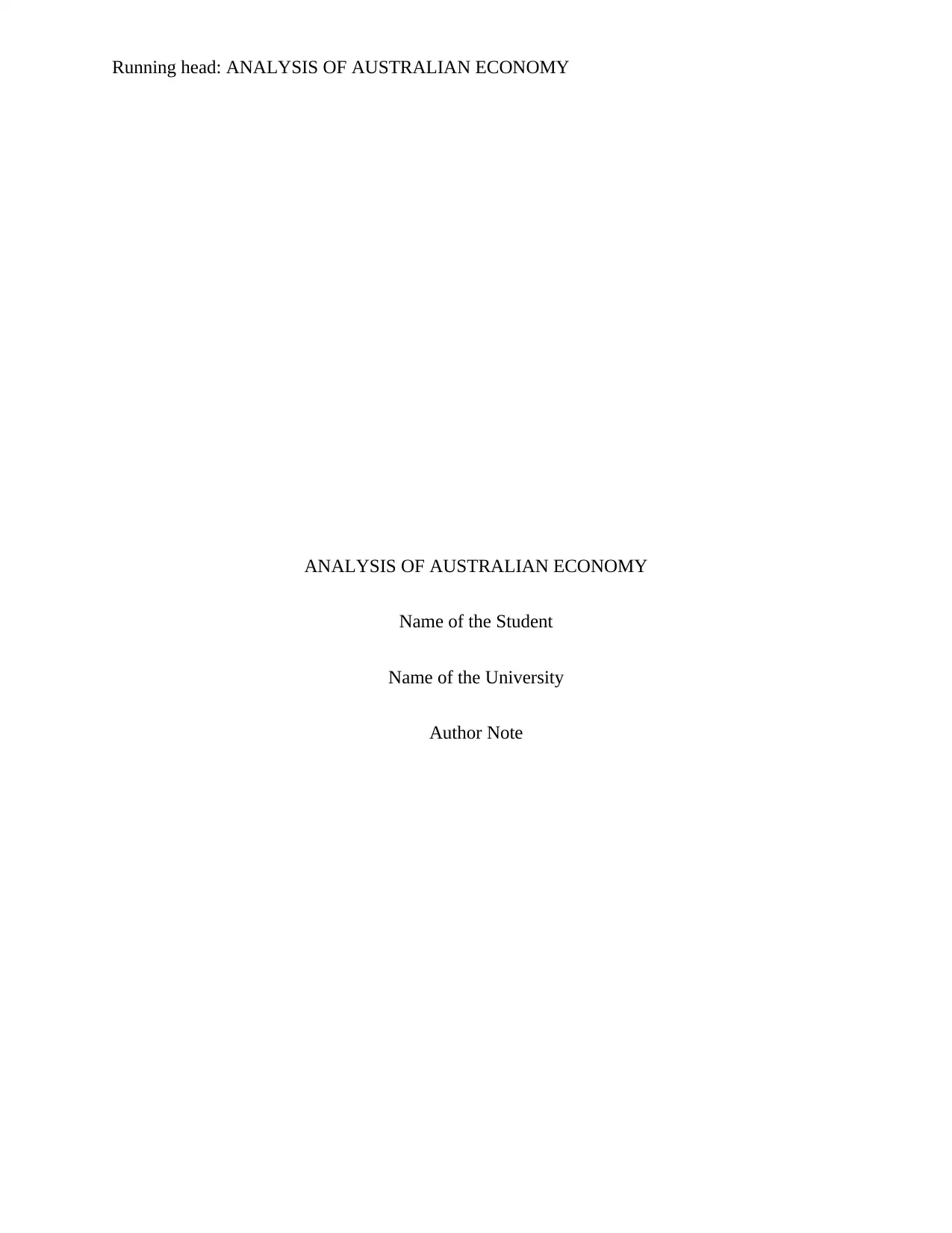
Running head: ANALYSIS OF AUSTRALIAN ECONOMY
ANALYSIS OF AUSTRALIAN ECONOMY
Name of the Student
Name of the University
Author Note
ANALYSIS OF AUSTRALIAN ECONOMY
Name of the Student
Name of the University
Author Note
Paraphrase This Document
Need a fresh take? Get an instant paraphrase of this document with our AI Paraphraser
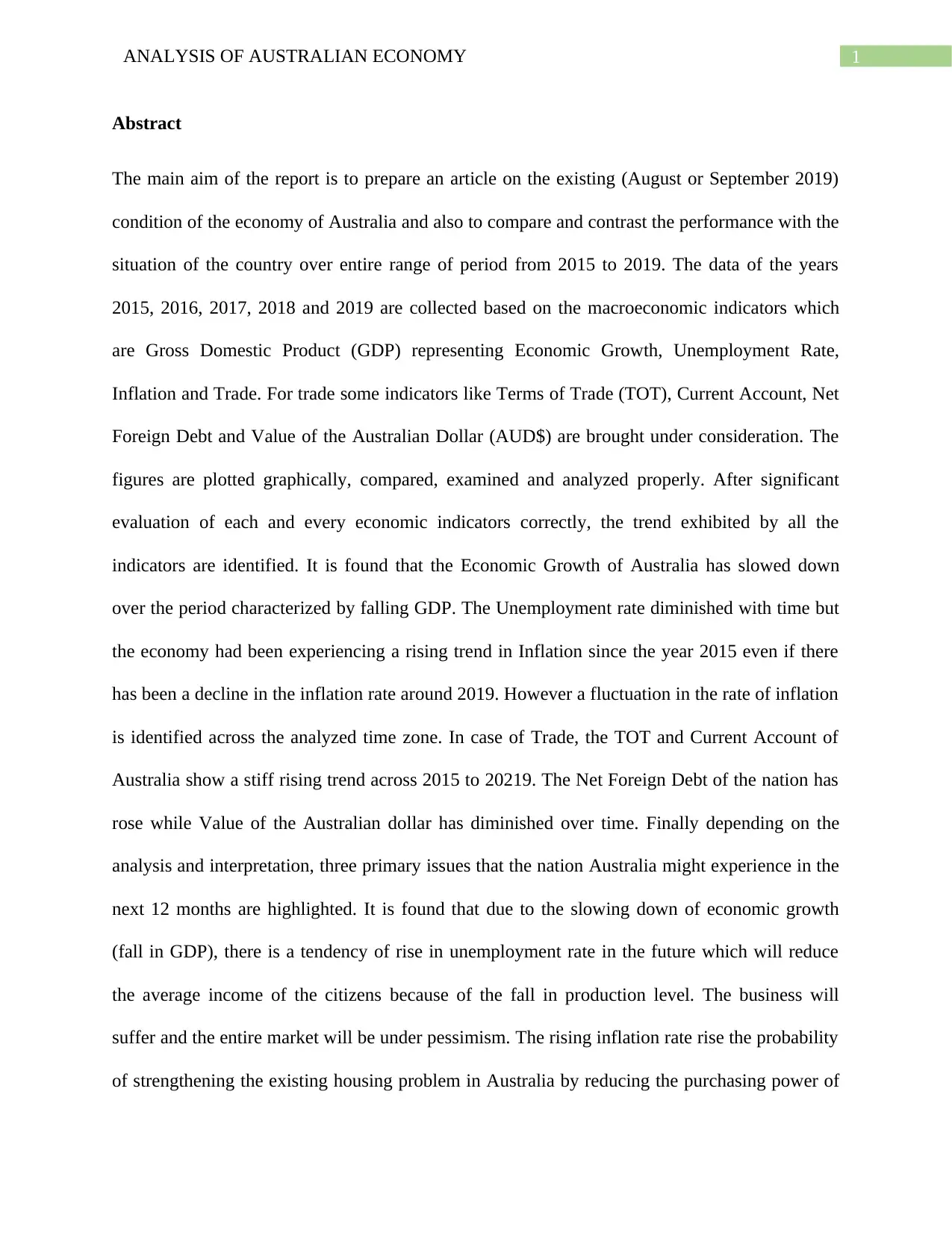
1ANALYSIS OF AUSTRALIAN ECONOMY
Abstract
The main aim of the report is to prepare an article on the existing (August or September 2019)
condition of the economy of Australia and also to compare and contrast the performance with the
situation of the country over entire range of period from 2015 to 2019. The data of the years
2015, 2016, 2017, 2018 and 2019 are collected based on the macroeconomic indicators which
are Gross Domestic Product (GDP) representing Economic Growth, Unemployment Rate,
Inflation and Trade. For trade some indicators like Terms of Trade (TOT), Current Account, Net
Foreign Debt and Value of the Australian Dollar (AUD$) are brought under consideration. The
figures are plotted graphically, compared, examined and analyzed properly. After significant
evaluation of each and every economic indicators correctly, the trend exhibited by all the
indicators are identified. It is found that the Economic Growth of Australia has slowed down
over the period characterized by falling GDP. The Unemployment rate diminished with time but
the economy had been experiencing a rising trend in Inflation since the year 2015 even if there
has been a decline in the inflation rate around 2019. However a fluctuation in the rate of inflation
is identified across the analyzed time zone. In case of Trade, the TOT and Current Account of
Australia show a stiff rising trend across 2015 to 20219. The Net Foreign Debt of the nation has
rose while Value of the Australian dollar has diminished over time. Finally depending on the
analysis and interpretation, three primary issues that the nation Australia might experience in the
next 12 months are highlighted. It is found that due to the slowing down of economic growth
(fall in GDP), there is a tendency of rise in unemployment rate in the future which will reduce
the average income of the citizens because of the fall in production level. The business will
suffer and the entire market will be under pessimism. The rising inflation rate rise the probability
of strengthening the existing housing problem in Australia by reducing the purchasing power of
Abstract
The main aim of the report is to prepare an article on the existing (August or September 2019)
condition of the economy of Australia and also to compare and contrast the performance with the
situation of the country over entire range of period from 2015 to 2019. The data of the years
2015, 2016, 2017, 2018 and 2019 are collected based on the macroeconomic indicators which
are Gross Domestic Product (GDP) representing Economic Growth, Unemployment Rate,
Inflation and Trade. For trade some indicators like Terms of Trade (TOT), Current Account, Net
Foreign Debt and Value of the Australian Dollar (AUD$) are brought under consideration. The
figures are plotted graphically, compared, examined and analyzed properly. After significant
evaluation of each and every economic indicators correctly, the trend exhibited by all the
indicators are identified. It is found that the Economic Growth of Australia has slowed down
over the period characterized by falling GDP. The Unemployment rate diminished with time but
the economy had been experiencing a rising trend in Inflation since the year 2015 even if there
has been a decline in the inflation rate around 2019. However a fluctuation in the rate of inflation
is identified across the analyzed time zone. In case of Trade, the TOT and Current Account of
Australia show a stiff rising trend across 2015 to 20219. The Net Foreign Debt of the nation has
rose while Value of the Australian dollar has diminished over time. Finally depending on the
analysis and interpretation, three primary issues that the nation Australia might experience in the
next 12 months are highlighted. It is found that due to the slowing down of economic growth
(fall in GDP), there is a tendency of rise in unemployment rate in the future which will reduce
the average income of the citizens because of the fall in production level. The business will
suffer and the entire market will be under pessimism. The rising inflation rate rise the probability
of strengthening the existing housing problem in Australia by reducing the purchasing power of
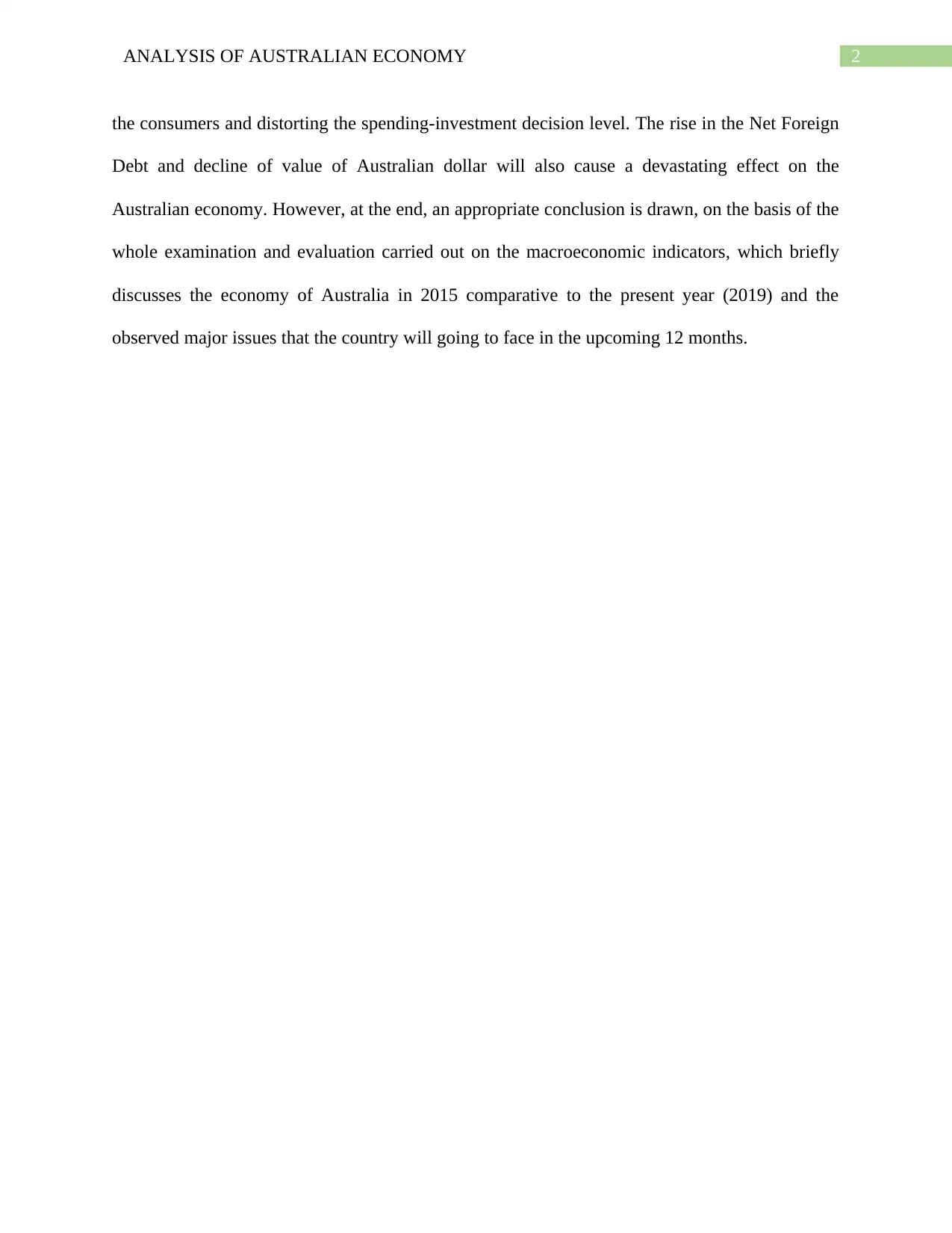
2ANALYSIS OF AUSTRALIAN ECONOMY
the consumers and distorting the spending-investment decision level. The rise in the Net Foreign
Debt and decline of value of Australian dollar will also cause a devastating effect on the
Australian economy. However, at the end, an appropriate conclusion is drawn, on the basis of the
whole examination and evaluation carried out on the macroeconomic indicators, which briefly
discusses the economy of Australia in 2015 comparative to the present year (2019) and the
observed major issues that the country will going to face in the upcoming 12 months.
the consumers and distorting the spending-investment decision level. The rise in the Net Foreign
Debt and decline of value of Australian dollar will also cause a devastating effect on the
Australian economy. However, at the end, an appropriate conclusion is drawn, on the basis of the
whole examination and evaluation carried out on the macroeconomic indicators, which briefly
discusses the economy of Australia in 2015 comparative to the present year (2019) and the
observed major issues that the country will going to face in the upcoming 12 months.
⊘ This is a preview!⊘
Do you want full access?
Subscribe today to unlock all pages.

Trusted by 1+ million students worldwide
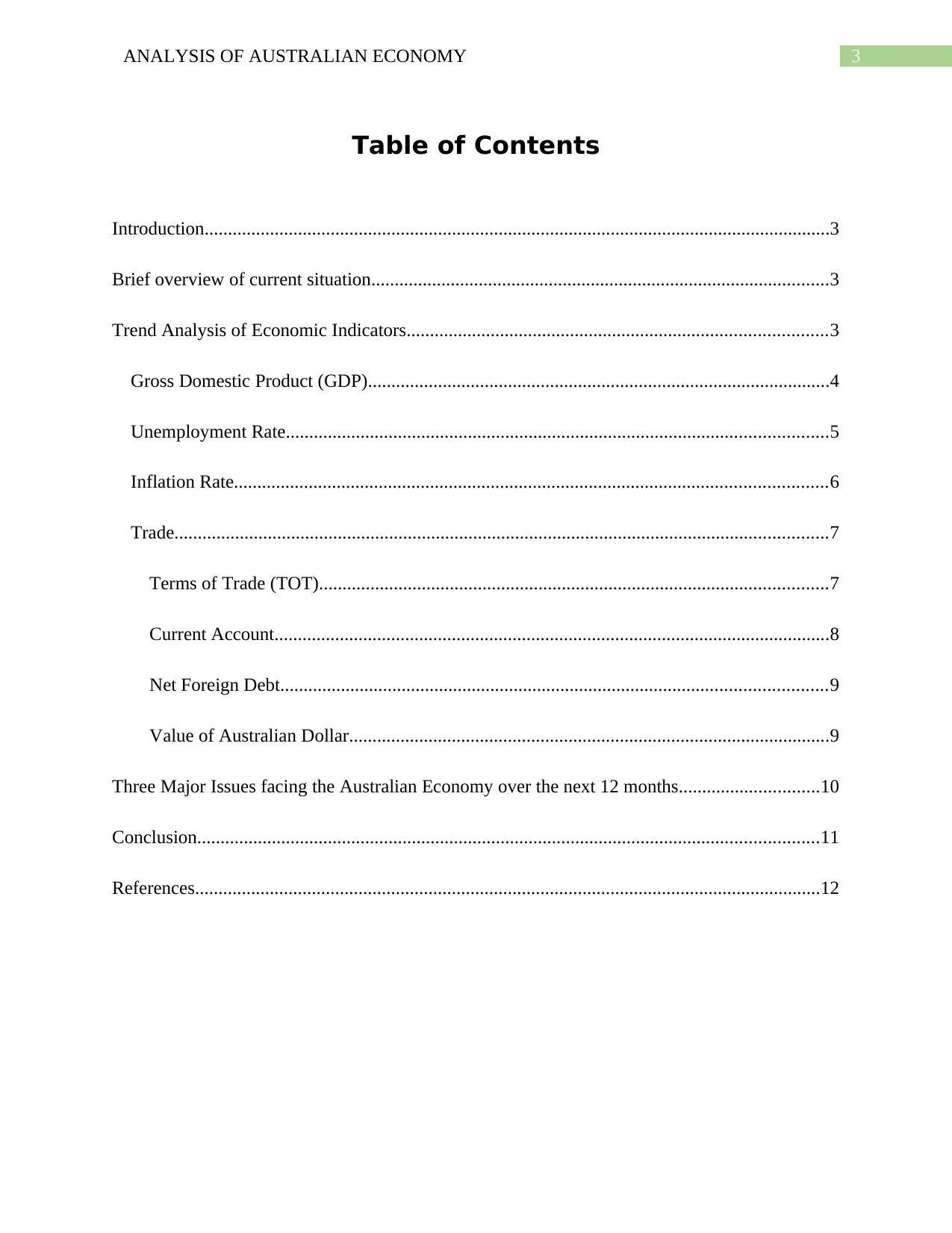
3ANALYSIS OF AUSTRALIAN ECONOMY
Table of Contents
Introduction......................................................................................................................................3
Brief overview of current situation..................................................................................................3
Trend Analysis of Economic Indicators..........................................................................................3
Gross Domestic Product (GDP)...................................................................................................4
Unemployment Rate....................................................................................................................5
Inflation Rate...............................................................................................................................6
Trade............................................................................................................................................7
Terms of Trade (TOT).............................................................................................................7
Current Account.......................................................................................................................8
Net Foreign Debt.....................................................................................................................9
Value of Australian Dollar.......................................................................................................9
Three Major Issues facing the Australian Economy over the next 12 months..............................10
Conclusion.....................................................................................................................................11
References......................................................................................................................................12
Table of Contents
Introduction......................................................................................................................................3
Brief overview of current situation..................................................................................................3
Trend Analysis of Economic Indicators..........................................................................................3
Gross Domestic Product (GDP)...................................................................................................4
Unemployment Rate....................................................................................................................5
Inflation Rate...............................................................................................................................6
Trade............................................................................................................................................7
Terms of Trade (TOT).............................................................................................................7
Current Account.......................................................................................................................8
Net Foreign Debt.....................................................................................................................9
Value of Australian Dollar.......................................................................................................9
Three Major Issues facing the Australian Economy over the next 12 months..............................10
Conclusion.....................................................................................................................................11
References......................................................................................................................................12
Paraphrase This Document
Need a fresh take? Get an instant paraphrase of this document with our AI Paraphraser
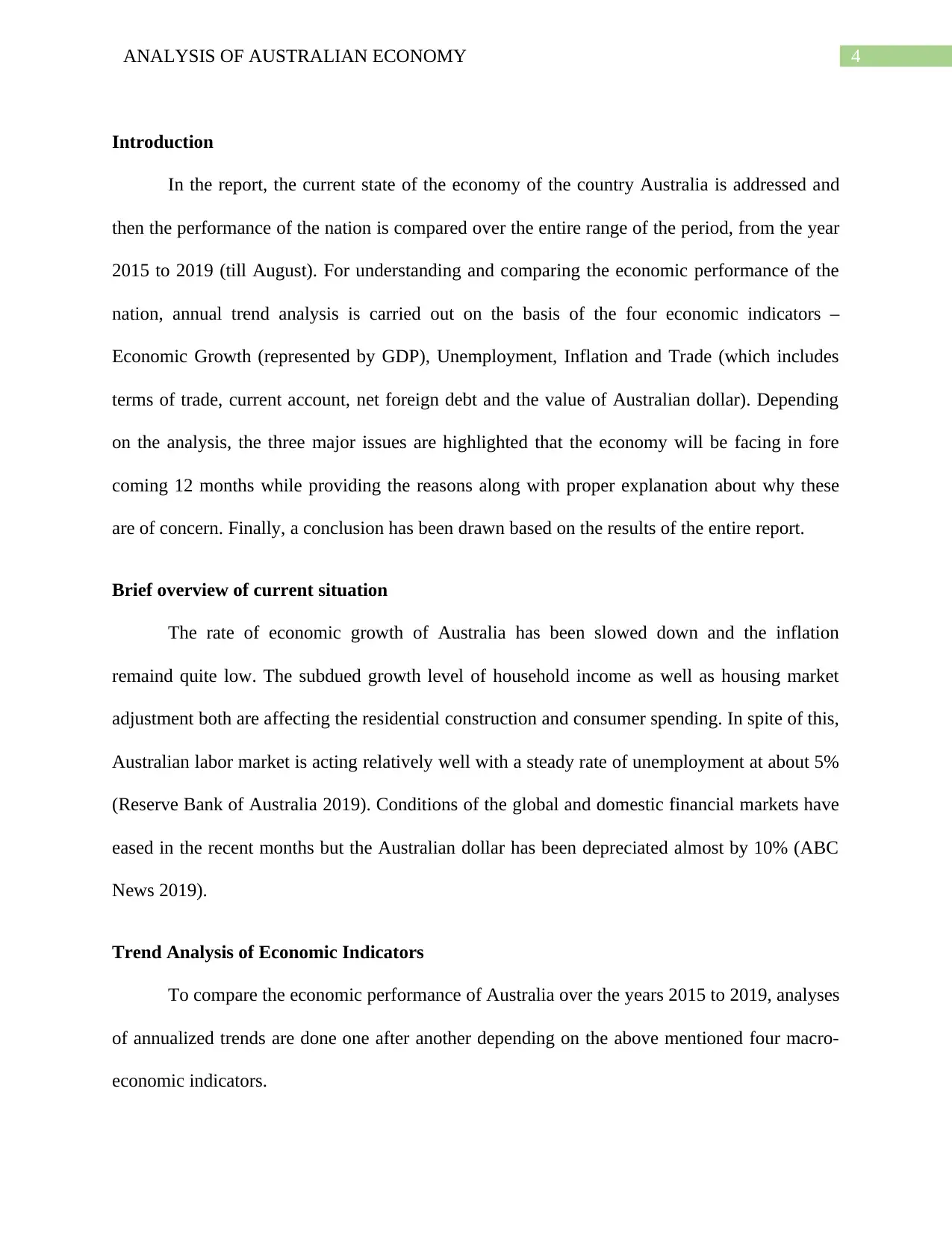
4ANALYSIS OF AUSTRALIAN ECONOMY
Introduction
In the report, the current state of the economy of the country Australia is addressed and
then the performance of the nation is compared over the entire range of the period, from the year
2015 to 2019 (till August). For understanding and comparing the economic performance of the
nation, annual trend analysis is carried out on the basis of the four economic indicators –
Economic Growth (represented by GDP), Unemployment, Inflation and Trade (which includes
terms of trade, current account, net foreign debt and the value of Australian dollar). Depending
on the analysis, the three major issues are highlighted that the economy will be facing in fore
coming 12 months while providing the reasons along with proper explanation about why these
are of concern. Finally, a conclusion has been drawn based on the results of the entire report.
Brief overview of current situation
The rate of economic growth of Australia has been slowed down and the inflation
remaind quite low. The subdued growth level of household income as well as housing market
adjustment both are affecting the residential construction and consumer spending. In spite of this,
Australian labor market is acting relatively well with a steady rate of unemployment at about 5%
(Reserve Bank of Australia 2019). Conditions of the global and domestic financial markets have
eased in the recent months but the Australian dollar has been depreciated almost by 10% (ABC
News 2019).
Trend Analysis of Economic Indicators
To compare the economic performance of Australia over the years 2015 to 2019, analyses
of annualized trends are done one after another depending on the above mentioned four macro-
economic indicators.
Introduction
In the report, the current state of the economy of the country Australia is addressed and
then the performance of the nation is compared over the entire range of the period, from the year
2015 to 2019 (till August). For understanding and comparing the economic performance of the
nation, annual trend analysis is carried out on the basis of the four economic indicators –
Economic Growth (represented by GDP), Unemployment, Inflation and Trade (which includes
terms of trade, current account, net foreign debt and the value of Australian dollar). Depending
on the analysis, the three major issues are highlighted that the economy will be facing in fore
coming 12 months while providing the reasons along with proper explanation about why these
are of concern. Finally, a conclusion has been drawn based on the results of the entire report.
Brief overview of current situation
The rate of economic growth of Australia has been slowed down and the inflation
remaind quite low. The subdued growth level of household income as well as housing market
adjustment both are affecting the residential construction and consumer spending. In spite of this,
Australian labor market is acting relatively well with a steady rate of unemployment at about 5%
(Reserve Bank of Australia 2019). Conditions of the global and domestic financial markets have
eased in the recent months but the Australian dollar has been depreciated almost by 10% (ABC
News 2019).
Trend Analysis of Economic Indicators
To compare the economic performance of Australia over the years 2015 to 2019, analyses
of annualized trends are done one after another depending on the above mentioned four macro-
economic indicators.
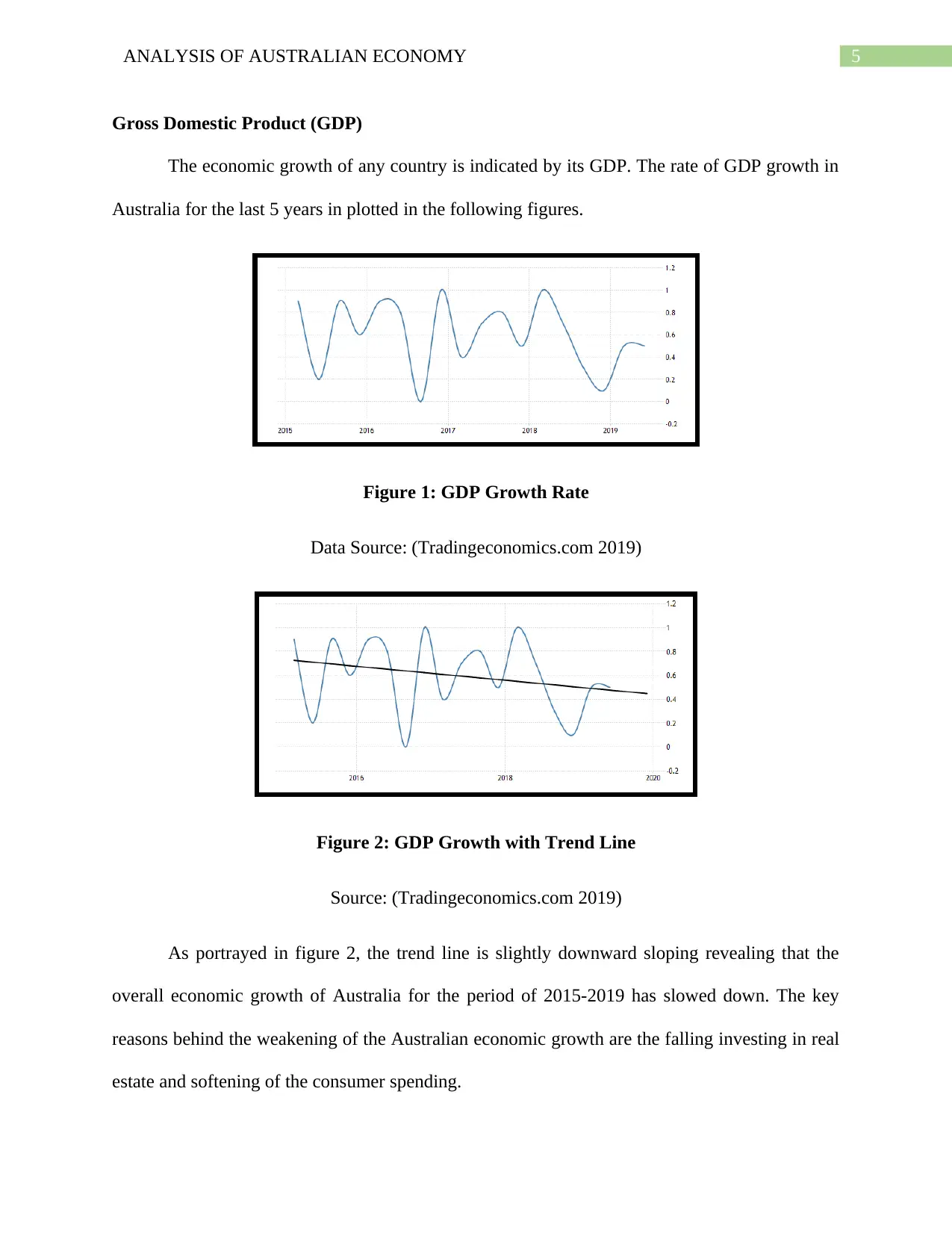
5ANALYSIS OF AUSTRALIAN ECONOMY
Gross Domestic Product (GDP)
The economic growth of any country is indicated by its GDP. The rate of GDP growth in
Australia for the last 5 years in plotted in the following figures.
Figure 1: GDP Growth Rate
Data Source: (Tradingeconomics.com 2019)
Figure 2: GDP Growth with Trend Line
Source: (Tradingeconomics.com 2019)
As portrayed in figure 2, the trend line is slightly downward sloping revealing that the
overall economic growth of Australia for the period of 2015-2019 has slowed down. The key
reasons behind the weakening of the Australian economic growth are the falling investing in real
estate and softening of the consumer spending.
Gross Domestic Product (GDP)
The economic growth of any country is indicated by its GDP. The rate of GDP growth in
Australia for the last 5 years in plotted in the following figures.
Figure 1: GDP Growth Rate
Data Source: (Tradingeconomics.com 2019)
Figure 2: GDP Growth with Trend Line
Source: (Tradingeconomics.com 2019)
As portrayed in figure 2, the trend line is slightly downward sloping revealing that the
overall economic growth of Australia for the period of 2015-2019 has slowed down. The key
reasons behind the weakening of the Australian economic growth are the falling investing in real
estate and softening of the consumer spending.
⊘ This is a preview!⊘
Do you want full access?
Subscribe today to unlock all pages.

Trusted by 1+ million students worldwide
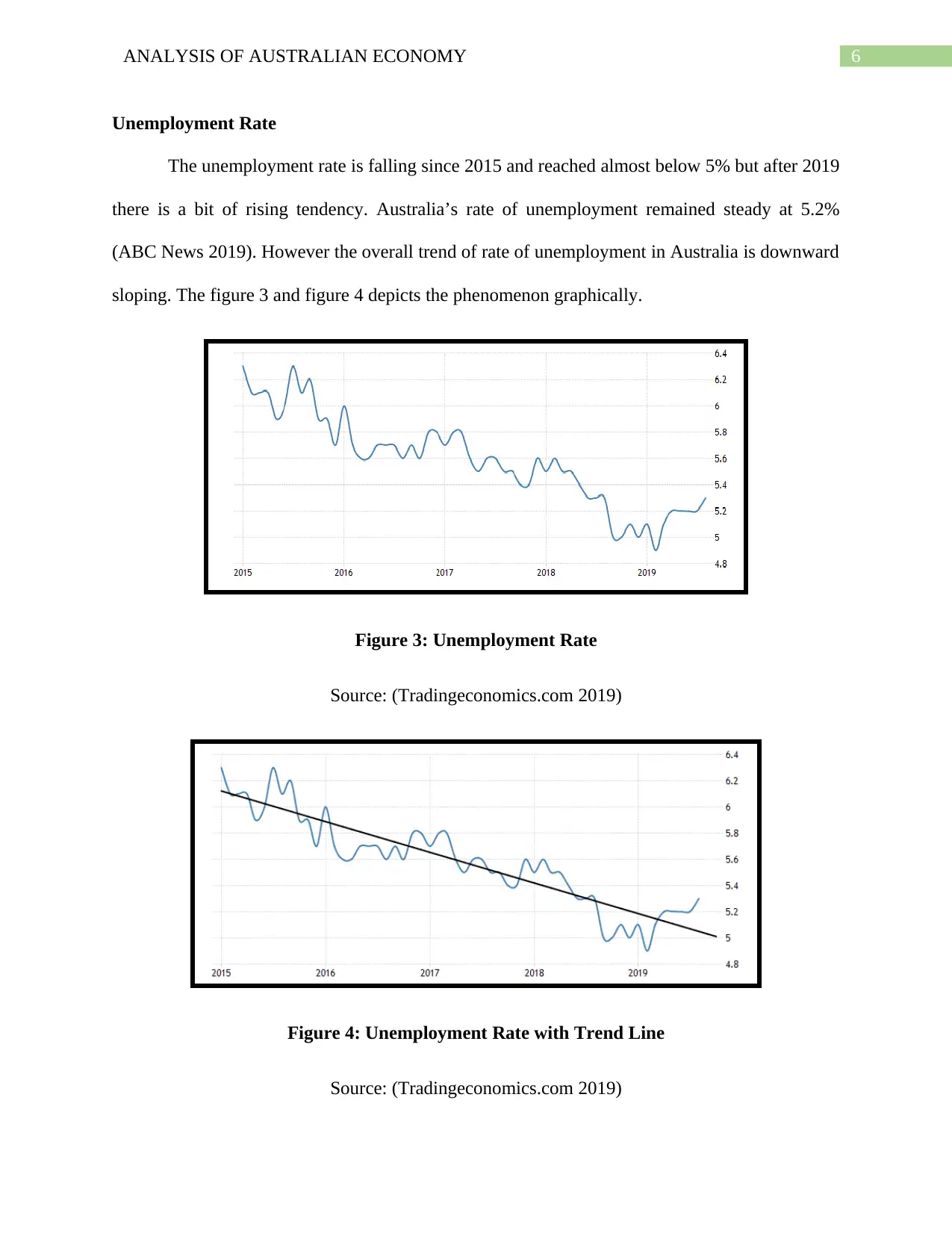
6ANALYSIS OF AUSTRALIAN ECONOMY
Unemployment Rate
The unemployment rate is falling since 2015 and reached almost below 5% but after 2019
there is a bit of rising tendency. Australia’s rate of unemployment remained steady at 5.2%
(ABC News 2019). However the overall trend of rate of unemployment in Australia is downward
sloping. The figure 3 and figure 4 depicts the phenomenon graphically.
Figure 3: Unemployment Rate
Source: (Tradingeconomics.com 2019)
Figure 4: Unemployment Rate with Trend Line
Source: (Tradingeconomics.com 2019)
Unemployment Rate
The unemployment rate is falling since 2015 and reached almost below 5% but after 2019
there is a bit of rising tendency. Australia’s rate of unemployment remained steady at 5.2%
(ABC News 2019). However the overall trend of rate of unemployment in Australia is downward
sloping. The figure 3 and figure 4 depicts the phenomenon graphically.
Figure 3: Unemployment Rate
Source: (Tradingeconomics.com 2019)
Figure 4: Unemployment Rate with Trend Line
Source: (Tradingeconomics.com 2019)
Paraphrase This Document
Need a fresh take? Get an instant paraphrase of this document with our AI Paraphraser
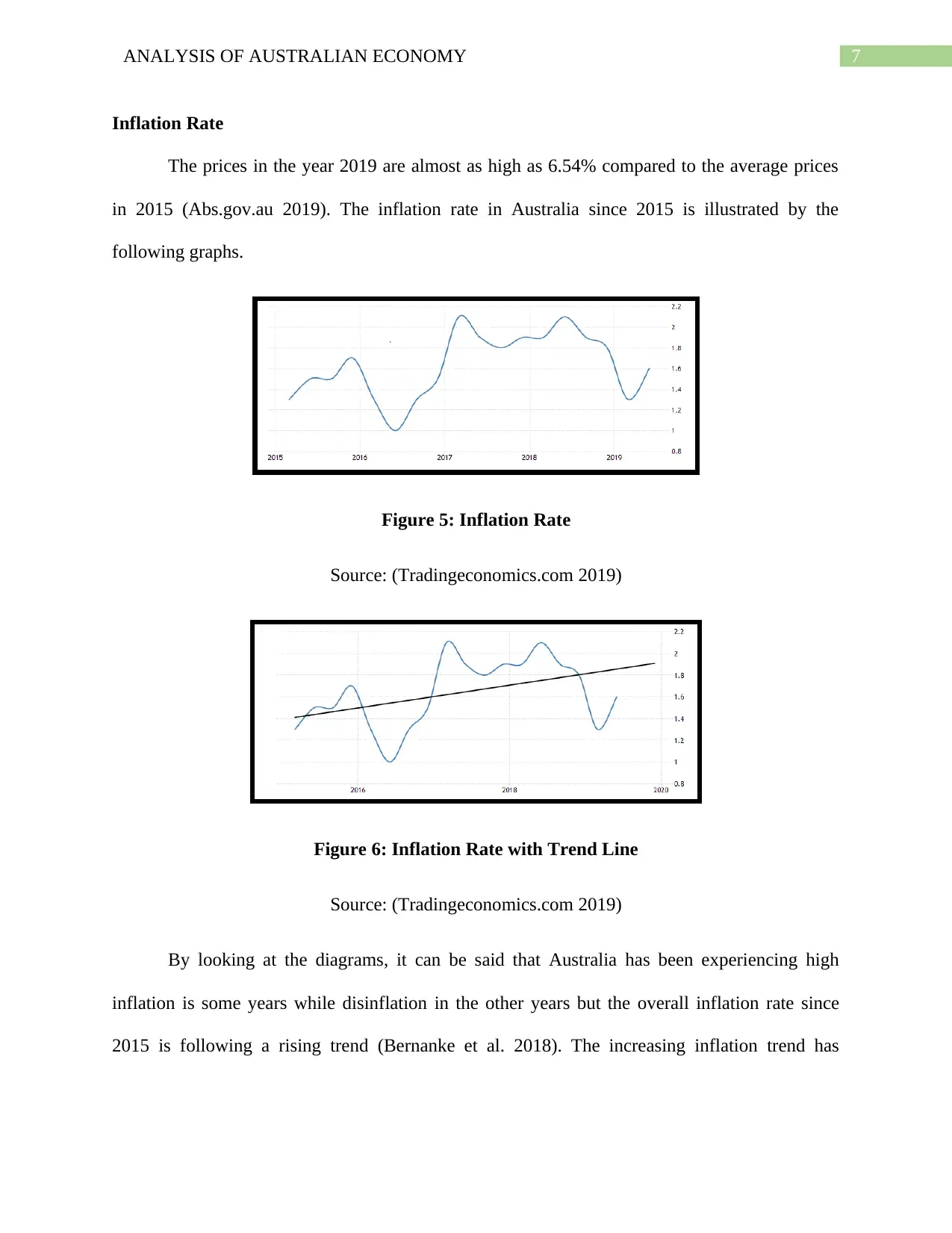
7ANALYSIS OF AUSTRALIAN ECONOMY
Inflation Rate
The prices in the year 2019 are almost as high as 6.54% compared to the average prices
in 2015 (Abs.gov.au 2019). The inflation rate in Australia since 2015 is illustrated by the
following graphs.
Figure 5: Inflation Rate
Source: (Tradingeconomics.com 2019)
Figure 6: Inflation Rate with Trend Line
Source: (Tradingeconomics.com 2019)
By looking at the diagrams, it can be said that Australia has been experiencing high
inflation is some years while disinflation in the other years but the overall inflation rate since
2015 is following a rising trend (Bernanke et al. 2018). The increasing inflation trend has
Inflation Rate
The prices in the year 2019 are almost as high as 6.54% compared to the average prices
in 2015 (Abs.gov.au 2019). The inflation rate in Australia since 2015 is illustrated by the
following graphs.
Figure 5: Inflation Rate
Source: (Tradingeconomics.com 2019)
Figure 6: Inflation Rate with Trend Line
Source: (Tradingeconomics.com 2019)
By looking at the diagrams, it can be said that Australia has been experiencing high
inflation is some years while disinflation in the other years but the overall inflation rate since
2015 is following a rising trend (Bernanke et al. 2018). The increasing inflation trend has
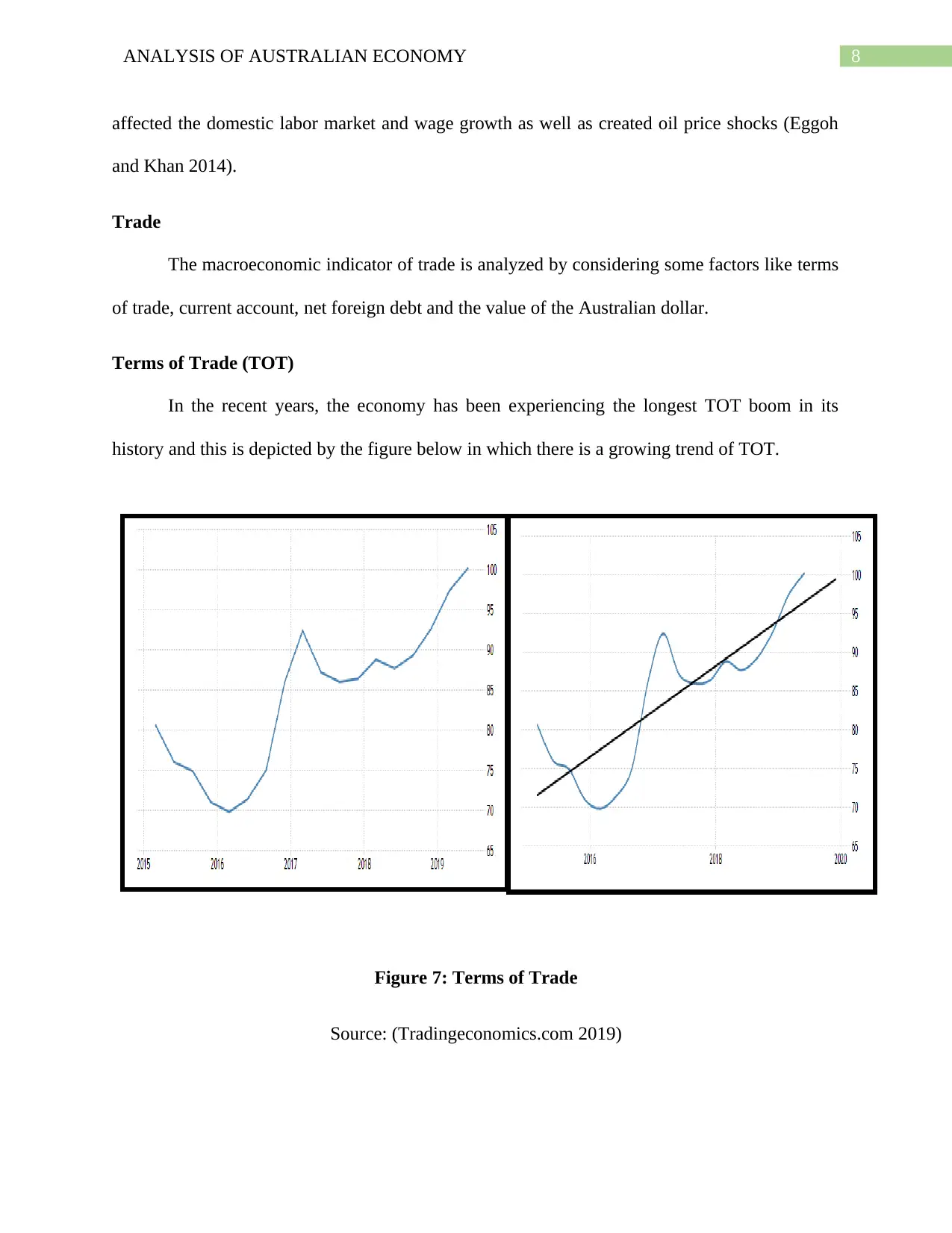
8ANALYSIS OF AUSTRALIAN ECONOMY
affected the domestic labor market and wage growth as well as created oil price shocks (Eggoh
and Khan 2014).
Trade
The macroeconomic indicator of trade is analyzed by considering some factors like terms
of trade, current account, net foreign debt and the value of the Australian dollar.
Terms of Trade (TOT)
In the recent years, the economy has been experiencing the longest TOT boom in its
history and this is depicted by the figure below in which there is a growing trend of TOT.
Figure 7: Terms of Trade
Source: (Tradingeconomics.com 2019)
affected the domestic labor market and wage growth as well as created oil price shocks (Eggoh
and Khan 2014).
Trade
The macroeconomic indicator of trade is analyzed by considering some factors like terms
of trade, current account, net foreign debt and the value of the Australian dollar.
Terms of Trade (TOT)
In the recent years, the economy has been experiencing the longest TOT boom in its
history and this is depicted by the figure below in which there is a growing trend of TOT.
Figure 7: Terms of Trade
Source: (Tradingeconomics.com 2019)
⊘ This is a preview!⊘
Do you want full access?
Subscribe today to unlock all pages.

Trusted by 1+ million students worldwide
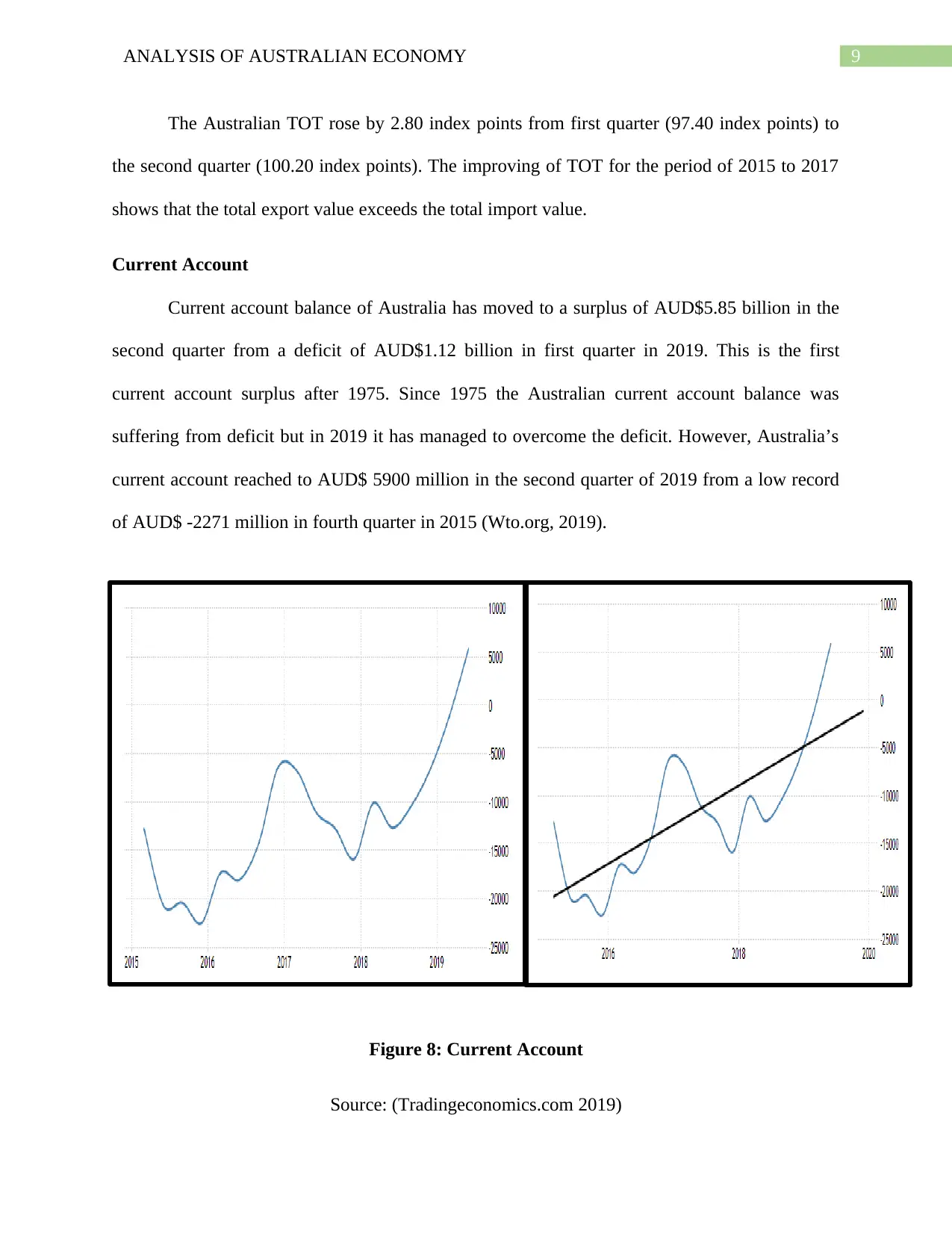
9ANALYSIS OF AUSTRALIAN ECONOMY
The Australian TOT rose by 2.80 index points from first quarter (97.40 index points) to
the second quarter (100.20 index points). The improving of TOT for the period of 2015 to 2017
shows that the total export value exceeds the total import value.
Current Account
Current account balance of Australia has moved to a surplus of AUD$5.85 billion in the
second quarter from a deficit of AUD$1.12 billion in first quarter in 2019. This is the first
current account surplus after 1975. Since 1975 the Australian current account balance was
suffering from deficit but in 2019 it has managed to overcome the deficit. However, Australia’s
current account reached to AUD$ 5900 million in the second quarter of 2019 from a low record
of AUD$ -2271 million in fourth quarter in 2015 (Wto.org, 2019).
Figure 8: Current Account
Source: (Tradingeconomics.com 2019)
The Australian TOT rose by 2.80 index points from first quarter (97.40 index points) to
the second quarter (100.20 index points). The improving of TOT for the period of 2015 to 2017
shows that the total export value exceeds the total import value.
Current Account
Current account balance of Australia has moved to a surplus of AUD$5.85 billion in the
second quarter from a deficit of AUD$1.12 billion in first quarter in 2019. This is the first
current account surplus after 1975. Since 1975 the Australian current account balance was
suffering from deficit but in 2019 it has managed to overcome the deficit. However, Australia’s
current account reached to AUD$ 5900 million in the second quarter of 2019 from a low record
of AUD$ -2271 million in fourth quarter in 2015 (Wto.org, 2019).
Figure 8: Current Account
Source: (Tradingeconomics.com 2019)
Paraphrase This Document
Need a fresh take? Get an instant paraphrase of this document with our AI Paraphraser
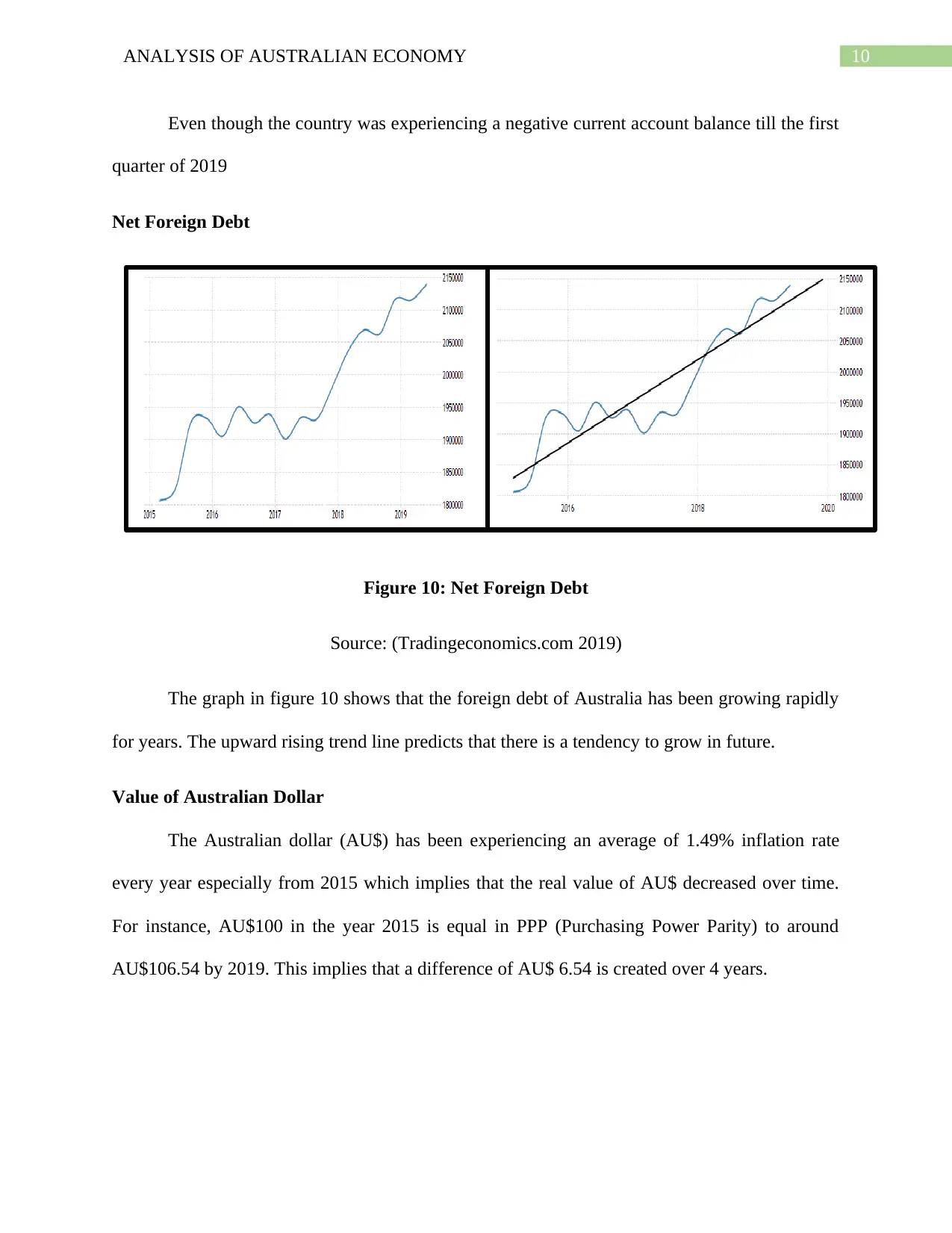
10ANALYSIS OF AUSTRALIAN ECONOMY
Even though the country was experiencing a negative current account balance till the first
quarter of 2019
Net Foreign Debt
Figure 10: Net Foreign Debt
Source: (Tradingeconomics.com 2019)
The graph in figure 10 shows that the foreign debt of Australia has been growing rapidly
for years. The upward rising trend line predicts that there is a tendency to grow in future.
Value of Australian Dollar
The Australian dollar (AU$) has been experiencing an average of 1.49% inflation rate
every year especially from 2015 which implies that the real value of AU$ decreased over time.
For instance, AU$100 in the year 2015 is equal in PPP (Purchasing Power Parity) to around
AU$106.54 by 2019. This implies that a difference of AU$ 6.54 is created over 4 years.
Even though the country was experiencing a negative current account balance till the first
quarter of 2019
Net Foreign Debt
Figure 10: Net Foreign Debt
Source: (Tradingeconomics.com 2019)
The graph in figure 10 shows that the foreign debt of Australia has been growing rapidly
for years. The upward rising trend line predicts that there is a tendency to grow in future.
Value of Australian Dollar
The Australian dollar (AU$) has been experiencing an average of 1.49% inflation rate
every year especially from 2015 which implies that the real value of AU$ decreased over time.
For instance, AU$100 in the year 2015 is equal in PPP (Purchasing Power Parity) to around
AU$106.54 by 2019. This implies that a difference of AU$ 6.54 is created over 4 years.
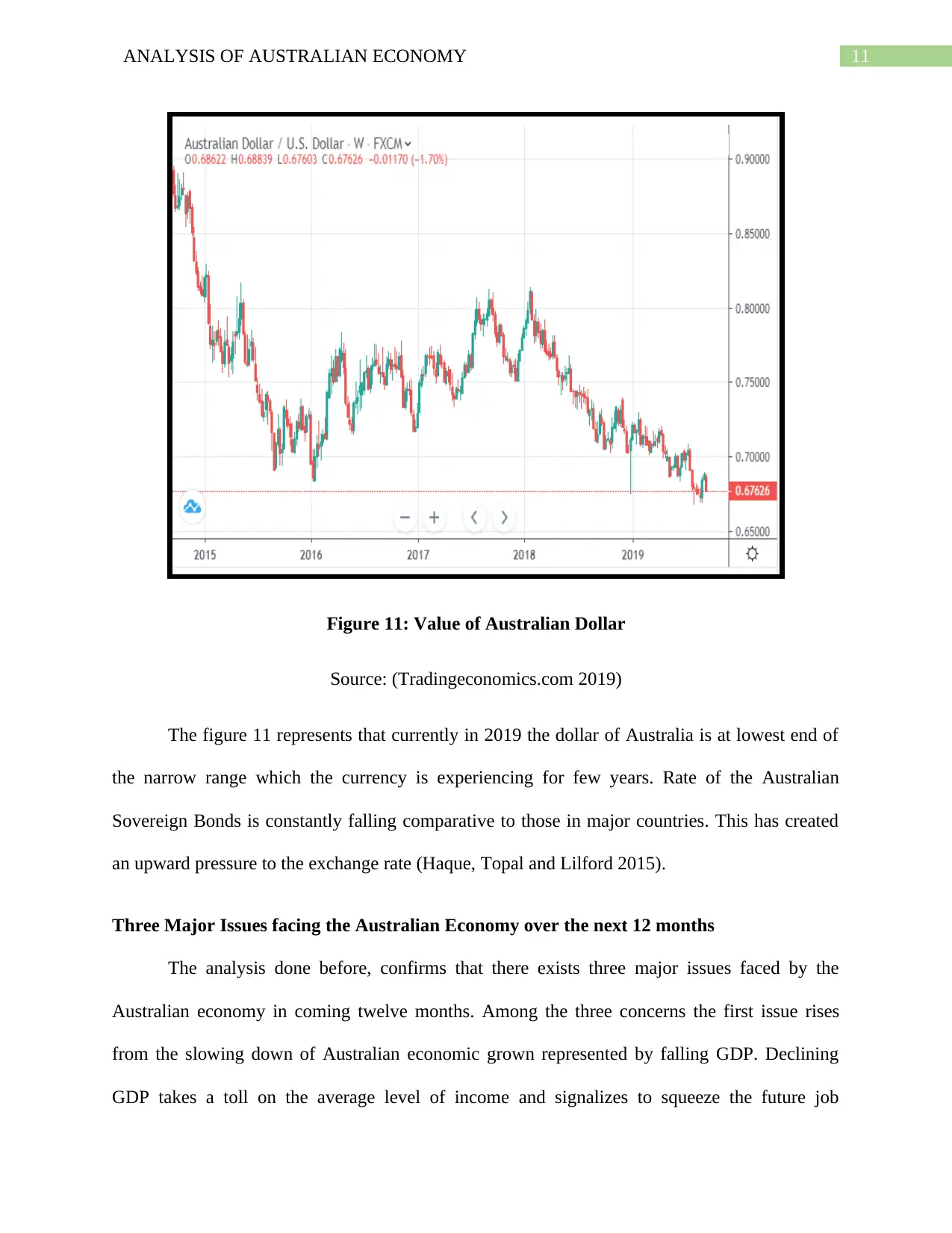
11ANALYSIS OF AUSTRALIAN ECONOMY
Figure 11: Value of Australian Dollar
Source: (Tradingeconomics.com 2019)
The figure 11 represents that currently in 2019 the dollar of Australia is at lowest end of
the narrow range which the currency is experiencing for few years. Rate of the Australian
Sovereign Bonds is constantly falling comparative to those in major countries. This has created
an upward pressure to the exchange rate (Haque, Topal and Lilford 2015).
Three Major Issues facing the Australian Economy over the next 12 months
The analysis done before, confirms that there exists three major issues faced by the
Australian economy in coming twelve months. Among the three concerns the first issue rises
from the slowing down of Australian economic grown represented by falling GDP. Declining
GDP takes a toll on the average level of income and signalizes to squeeze the future job
Figure 11: Value of Australian Dollar
Source: (Tradingeconomics.com 2019)
The figure 11 represents that currently in 2019 the dollar of Australia is at lowest end of
the narrow range which the currency is experiencing for few years. Rate of the Australian
Sovereign Bonds is constantly falling comparative to those in major countries. This has created
an upward pressure to the exchange rate (Haque, Topal and Lilford 2015).
Three Major Issues facing the Australian Economy over the next 12 months
The analysis done before, confirms that there exists three major issues faced by the
Australian economy in coming twelve months. Among the three concerns the first issue rises
from the slowing down of Australian economic grown represented by falling GDP. Declining
GDP takes a toll on the average level of income and signalizes to squeeze the future job
⊘ This is a preview!⊘
Do you want full access?
Subscribe today to unlock all pages.

Trusted by 1+ million students worldwide
1 out of 15
Related Documents
Your All-in-One AI-Powered Toolkit for Academic Success.
+13062052269
info@desklib.com
Available 24*7 on WhatsApp / Email
![[object Object]](/_next/static/media/star-bottom.7253800d.svg)
Unlock your academic potential
Copyright © 2020–2025 A2Z Services. All Rights Reserved. Developed and managed by ZUCOL.





